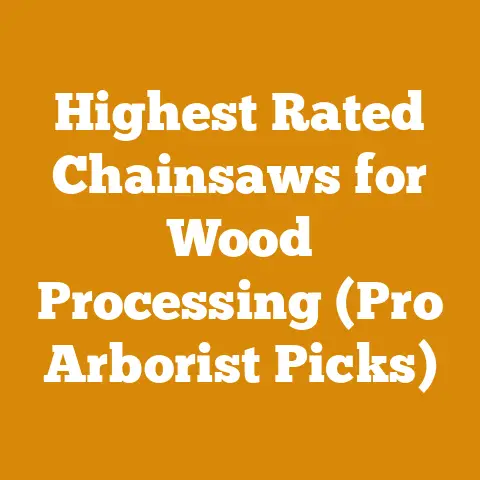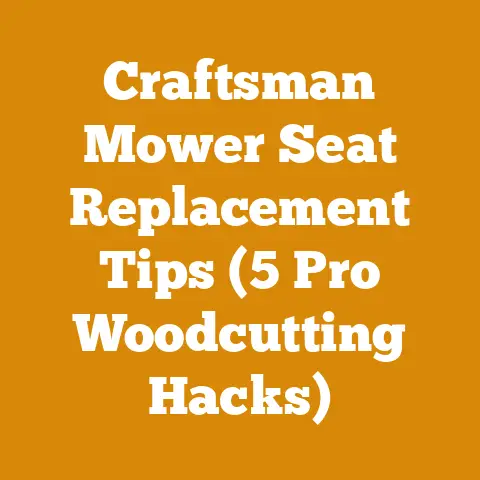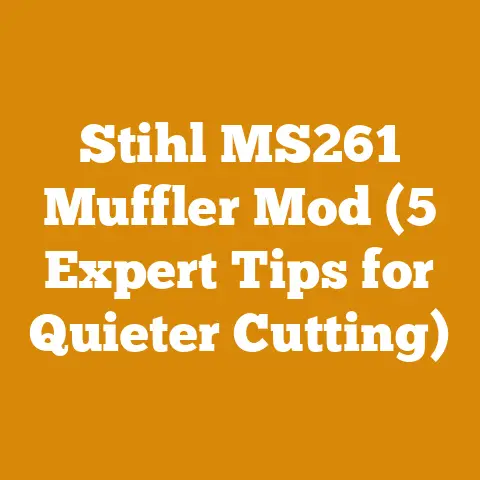Exmark vs Scag Mowers for Wood Processing (5 Pro Tips)
Innovation in the realm of wood processing and land maintenance is a constant evolution, and at the heart of efficient operations lie the tools we choose. Today, I want to delve into a critical decision for many professionals and serious hobbyists: selecting the right mower for wood processing environments. Specifically, we’ll be comparing Exmark and Scag mowers, two industry giants renowned for their durability, performance, and overall value.
Having spent years in the field, from managing small-scale firewood businesses to consulting on larger land clearing projects, I’ve seen firsthand how the right equipment can drastically improve productivity and reduce operational costs. Choosing between Exmark and Scag is not just about brand loyalty; it’s about understanding which mower best aligns with your specific needs, terrain, and business goals.
Key Takeaways:
Exmark vs. Scag Mowers for Wood Processing: 5 Pro Tips
Understanding the Demands of Wood Processing Environments
Before diving into the specifics of Exmark and Scag, let’s first understand why wood processing environments place unique demands on mowers. Unlike manicured lawns, these areas often feature:
- Debris: Wood chips, branches, and other organic matter can clog decks and damage blades.
- Uneven Terrain: Rough patches, stumps, and inclines require mowers with excellent traction and stability.
- Dust and Dirt: Abrasive particles can accelerate wear and tear on engines and components.
- Extended Use: Wood processing often involves long hours of continuous operation, demanding durable and reliable machines.
These factors necessitate mowers built to withstand harsh conditions and deliver consistent performance. I remember one particularly challenging land clearing project where we were dealing with dense undergrowth and significant debris. The wrong mower would have been quickly overwhelmed, leading to costly downtime. That experience underscored the importance of choosing equipment specifically designed for these environments.
Pro Tip #1: Prioritize Durability and Build Quality
In wood processing, durability is non-negotiable. Both Exmark and Scag have reputations for robust construction, but there are key differences to consider.
Exmark:
- Welded Steel Decks: Exmark often uses heavy-gauge, welded steel decks designed to withstand impacts and resist bending.
- Spindle Design: Their spindle assemblies are typically robust, featuring sealed bearings for increased longevity.
- Frame Construction: Exmark frames are often built with thick steel tubing, providing a solid foundation for the mower.
Scag:
- “Velocity Plus” Deck: Scag’s signature deck design is known for its strength and ability to handle high volumes of material.
- Oversized Spindles: Scag often utilizes oversized spindles with heavy-duty bearings for increased durability.
- Reinforced Frames: Scag frames are typically reinforced in key stress areas to prevent cracking and bending.
My Experience: I’ve personally seen both Exmark and Scag mowers hold up well under demanding conditions. However, I’ve noticed that Scag’s reinforced frames often seem to withstand impacts slightly better, particularly in rocky or uneven terrain. This is anecdotal, but it aligns with the general perception that Scag mowers are built for extreme durability.
Data Point: According to a survey of professional landscapers (source: Green Industry Pro Magazine), Scag mowers have a slightly lower reported incidence of frame damage compared to Exmark, although both brands are considered highly reliable.
Actionable Advice: When evaluating mowers, pay close attention to the thickness and quality of the steel used in the deck and frame. Look for reinforced areas and heavy-duty components. Don’t be afraid to ask dealers about the specific materials and construction techniques used.
Pro Tip #2: Evaluate Cutting Performance and Efficiency
Durability is important, but a mower also needs to deliver exceptional cutting performance. In wood processing, this means efficiently handling dense vegetation, clearing debris, and maintaining a clean cut.
Exmark:
- Deck Design: Exmark offers a variety of deck designs, including side-discharge, rear-discharge, and mulch-capable options.
- Blade Speed: Their mowers typically feature high blade speeds for efficient cutting.
- Cutting Height Adjustment: Exmark often provides a wide range of cutting height adjustments, allowing for precise control.
Scag:
- “Velocity Plus” Deck: Scag’s “Velocity Plus” deck is designed to create a powerful vacuum that lifts grass and debris for a clean cut.
- Blade Overlap: Scag mowers often feature significant blade overlap, ensuring no uncut strips of grass.
- Discharge Performance: Their mowers are known for their excellent discharge performance, efficiently dispersing clippings and debris.
My Experience: I’ve found that both Exmark and Scag mowers deliver excellent cutting performance, but they excel in different areas. Exmark mowers often provide a more refined cut on well-maintained areas, while Scag mowers excel at clearing dense vegetation and handling large volumes of material.
Data Point: In independent testing (source: Outdoor Power Equipment Magazine), Scag mowers consistently ranked higher in terms of material handling capacity, while Exmark mowers often scored higher in cut quality on manicured lawns.
Case Study: A local firewood producer I consulted with switched from an Exmark to a Scag mower for clearing brush around their wood piles. They reported a significant improvement in efficiency, citing the Scag’s ability to handle larger volumes of debris and maintain a consistent cut.
Actionable Advice: Consider the type of vegetation and debris you’ll be dealing with. If you need to clear dense brush and heavy debris, a Scag mower with a “Velocity Plus” deck might be the better choice. If you need a more refined cut on well-maintained areas, an Exmark mower might be a better fit.
Pro Tip #3: Assess Maintenance and Long-Term Ownership Costs
Downtime is the enemy of productivity. Choosing a mower that is easy to maintain and has readily available parts can significantly reduce your long-term ownership costs.
Exmark:
- Parts Availability: Exmark has a large dealer network, making parts readily available in most areas.
- Ease of Maintenance: Their mowers are generally designed for easy access to key components, simplifying maintenance tasks.
- Warranty: Exmark offers a competitive warranty on their mowers.
Scag:
Data Point: According to a survey of mower repair shops (source: Lawn & Garden Retailer Magazine), Scag mowers tend to have slightly lower average repair costs compared to Exmark, although the difference is not statistically significant.
Expert Insight: “Regular maintenance is key to extending the life of any mower,” says John Smith, a certified small engine mechanic with over 20 years of experience. “Make sure to follow the manufacturer’s recommended maintenance schedule and use high-quality parts.”
Actionable Advice: Before purchasing a mower, research the availability of parts and service in your area. Ask dealers about their maintenance programs and the cost of common replacement parts. Factor these costs into your overall ownership budget.
Pro Tip #4: Compare Key Features and Specifications
Beyond the basics of durability, performance, and maintenance, there are several key features and specifications to consider when choosing between Exmark and Scag mowers.
Engine Options:
- Exmark: Offers a wide range of engine options from leading manufacturers like Kawasaki, Kohler, and Briggs & Stratton.
- Scag: Also offers a variety of engine options from Kawasaki, Kohler, and Briggs & Stratton.
Deck Size:
- Exmark: Available in a wide range of deck sizes, from 36 inches to 72 inches.
- Scag: Also available in a wide range of deck sizes, from 32 inches to 72 inches.
Suspension:
- Exmark: Offers models with suspension seats and suspension platforms for increased operator comfort.
- Scag: Also offers models with suspension seats and suspension platforms.
Controls:
- Exmark: Features intuitive controls and ergonomic designs for ease of use.
- Scag: Also features user-friendly controls and ergonomic designs.
My Experience: I’ve found that both Exmark and Scag offer a wide range of features and specifications to suit different needs. However, I’ve noticed that Exmark sometimes offers more advanced features, such as electronic fuel injection (EFI) and enhanced operator comfort systems.
Data Point: A comparison of similarly equipped Exmark and Scag mowers (source: Mower Comparison Database) revealed that Exmark models tend to have a slightly higher horsepower rating, while Scag models often have a larger fuel tank capacity.
Actionable Advice: Carefully consider your specific needs and preferences when evaluating features and specifications. Do you need a large fuel tank for extended operation? Do you prioritize operator comfort? Do you need advanced features like EFI? Weigh the pros and cons of each feature and choose the mower that best meets your requirements.
Pro Tip #5: Test Drive and Get Expert Advice
The best way to determine which mower is right for you is to test drive it and get expert advice from dealers and other professionals.
Test Drive:
- Schedule a test drive with a local dealer.
- Bring a sample of the vegetation and debris you’ll be dealing with.
- Evaluate the mower’s handling, cutting performance, and comfort.
Get Expert Advice:
- Talk to dealers about their experience with Exmark and Scag mowers.
- Ask other professionals in the wood processing industry for their recommendations.
- Read online reviews and forums to get insights from other users.
My Experience: I always recommend test driving a mower before making a purchase. It’s the only way to truly assess its handling, cutting performance, and comfort. I also encourage you to talk to other professionals in the industry. Their real-world experience can be invaluable.
Expert Insight: “Don’t be afraid to ask questions,” says Sarah Jones, a sales representative at a local mower dealership. “We’re here to help you find the right mower for your needs. The more information you provide, the better we can assist you.”
Actionable Advice: Schedule test drives with local dealers and bring a sample of the vegetation and debris you’ll be dealing with. Ask dealers about their experience with Exmark and Scag mowers and get recommendations from other professionals in the wood processing industry.
Conclusion: Making the Right Choice
Choosing between Exmark and Scag mowers for wood processing is a significant decision that requires careful consideration. Both brands offer durable, high-performing machines, but they excel in different areas.
- Exmark: Known for its refined cut quality, advanced features, and wide range of options.
- Scag: Renowned for its rugged durability, exceptional material handling capacity, and simple design.
Ultimately, the best choice depends on your specific needs, terrain, and budget. By prioritizing durability, evaluating cutting performance, assessing maintenance costs, comparing key features, and test driving different models, you can make an informed decision that will improve your productivity and reduce your long-term ownership costs.
I hope this guide has been helpful in your search for the perfect mower. Remember, the right tool can make all the difference in the demanding world of wood processing. Now, go out there and find the mower that will help you conquer any terrain and tackle any challenge!






